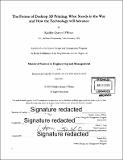The future of desktop 3D printing : what stands in the way and how the technology will advance
Author(s)
O'Brien, Kaitlyn Quinn
DownloadFull printable version (25.07Mb)
Alternative title
Future of desktop 3-dimensional printing : what stands in the way and how the technology will advance
Future of desktop three-dimensional printing : what stands in the way and how the technology will advance
Other Contributors
Massachusetts Institute of Technology. Engineering Systems Division.
Advisor
Maria C. Yang.
Terms of use
Metadata
Show full item recordAbstract
There has been significant excitement surrounding the potential of desktop 3D printing. Some predict that household ownership for some users is only a few years away, while others go as far as to assert desktop printers will follow a comparable trajectory to personal computers. This thesis challenges the validity of these claims and presents a more realistic future state for desktop 3D printing based on the barriers that the industry faces today. This thesis also provides valuable insight into the technological and social improvement areas on which lead users, makers paces, and manufacturers alike must focus in order to take the steps necessary to transform desktop 3D printing into a viable, valuable, and usable technology for the masses. This thesis includes four elements: 1) a thorough literature review, 2) a review of industrial and desktop 3D printers, 3) field interviews with existing and potential users, and 4) a makerspace review. Together, these study areas provide a system-level view of the current state of the desktop 3D printing industry, reveal a unique set of barriers preventing the technology from reaching the mainstream stage, and offer valuable evaluations regarding the efficacy of active enabling mechanisms. It is shown that, although the current enablers will eventually help push desktop 3D printing utilization to the mainstream stage, a significant amount of time and energy must be dedicated to this effort. Over the course of the next ten years, a sharp increase in the use of desktop 3D printing will be observed, but this use will be limited almost exclusively to users accessing 3D printers via qualified technologists in makerspaces and other educational settings. It will be crucial for lead users and manufacturers to focus on fostering the current enablers and implementing the potential enablers over the course of the next ten years in order for users to understand and be able to capture the value of desktop 3D printing.
Description
Thesis: S.M. in Engineering and Management, Massachusetts Institute of Technology, School of Engineering, System Design and Management Program, Engineering and Management Program, 2015. Cataloged from PDF version of thesis. Includes bibliographical references (pages 110-112).
Date issued
2015Department
Massachusetts Institute of Technology. Engineering and Management Program; System Design and Management Program.Publisher
Massachusetts Institute of Technology
Keywords
Engineering and Management Program., System Design and Management Program., Engineering Systems Division.